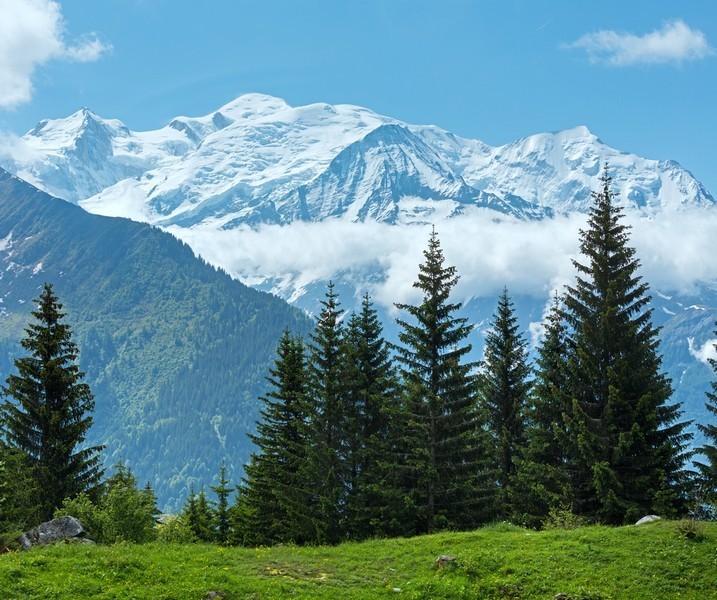7. Mountains have developed millions of years ago
Contents
Earth's mountain ranges
7.1 Earth's mountains
 Use the interactive map above to familiarize yourself with planet Earth's many mountain ranges.
Use the interactive map above to familiarize yourself with planet Earth's many mountain ranges. In this chapter, we will focus on some of the key features of these mountain ranges. We will use the mountains of Europe as a case study.
Mountainous areas can be distinguished on a map by their brown color. The darker the color of a mountain range is, the higher its elevation.
The map on the right displays the most prominent mountain ranges on the planet in dark brown: the American Cordillera (the Rocky Mountains and the Andes) and the Asian Himalayas.
7.2 Young and old orogenic mountains

The gradual movement of tectonic plates has resulted in the formation of orogenic mountain ranges. These mountain ranges have developed on border zones where two tectonic plates have slowly collided. The process has taken millions of years.
 When two tectonic plates collide, their edges are folded. This creates a series of folded mountains. As tectonic plates continue their movement to this day - albeit at a relatively slow pace of a couple of centimeters per year - all orogenic mountain ranges are still developing, and will continue to grow taller over time.
When two tectonic plates collide, their edges are folded. This creates a series of folded mountains. As tectonic plates continue their movement to this day - albeit at a relatively slow pace of a couple of centimeters per year - all orogenic mountain ranges are still developing, and will continue to grow taller over time.
When the age of a folded or orogenic mountain range can be measured in tens of millions of years, the mountain range is called a young orogenic mountain range. Examples of such mountain ranges include all the well-known mountain ranges of Central and Southern Europe: the Alps, the Pyrenees, the Apennines, the Carpathian Mountains, and the Balkans.
The American Cordillera is the longest chain of orogenic mountain ranges in the world. The Cordillera consists of many different mountain ranges, such as the North American Rocky Mountains and the South American Andes.
The young mountain ranges of the American Cordillera were formed approximately 60 million years ago. When most people think of mountains, they usually visualize something along the line of the vistas of the Rockies and the Andes: tall mountains with sharp peaks and steep slopes. These are the features common to all young orogenic mountain ranges.
When the age of a folded mountain range is measured in hundreds of millions of years, it is considered an old orogenic mountain range. An excellent example of this kind of a mountain range is found on the border of eastern Europe and Asia. This mountain range, the Ural Mountains, was formed over 300 million years ago. Another example of an old orogenic mountain range are the Appalachian Mountains of the eastern United States.
 Old orogenic mountain ranges have been subject to external or exogenous processes for hundreds of millions of years. These processes, such as ice, water, weathering, and erosion, have transformed the looks of these mountain ranges significantly. As a result, old orogenic mountain ranges are characterized by their low mountains and gentle slopes.
Old orogenic mountain ranges have been subject to external or exogenous processes for hundreds of millions of years. These processes, such as ice, water, weathering, and erosion, have transformed the looks of these mountain ranges significantly. As a result, old orogenic mountain ranges are characterized by their low mountains and gentle slopes.
In the beginning of a mountain range's formation, the mountains are subject to wear through processes like erosion and weathering. These processes wear out the exterior layers of the mountains, which consist of weaker types of rock than the interior layers. After hundreds of millions years of wear, only the strongest, central parts of the mountains are left.
The picture on the right shows the Appalachian Mountains, which are an old orogenic mountain range in the eastern United States. Exogenous processes have worn down the peaks until they have become flat and round.
7.3 European mountain ranges
The map of Europe displays great variation in elevation. Most of the European continent consists of lowland areas, whereas only one third consists of highlands and mountains. The European continent contains only a few depressions, or areas that are located below sea level.
The movement of tectonic plates has created the European folded mountain ranges over the course of hundreds of millions of years. These mountain ranges include the Alps, the Pyrenees, the Apennines, the Balkans and the Carpathian Mountains. They are all considered to be young orogenic mountain ranges, characterized by tall mountains, sharp peaks and steep slopes. In contrast, the Ural Mountains of Russia are an old orogenic mountain range.
The Scandes of Scandinavia are an old mountain range that has formed hundreds of millions of years ago. However, the mountain range also contains peaks that have formed only a couple of million years ago.

Summary
 Mountain ranges are formed as a result of the collision of tectonic plates.
Mountain ranges are formed as a result of the collision of tectonic plates.- Young orogenic mountain ranges have formed tens of millions of years ago. They are characterized by tall mountains, sharp peaks and steep slopes.
- Old orogenic mountain ranges have formed hundreds of millions of years ago. Exogenic processes have worn down these mountain ranges, making their peaks flat and their slopes gentle.
- Many mountain ranges contain volcanoes.
- Key words: mountain range, young orogenic mountain range, old orogenic mountain range.
- Mountain ranges: The Rocky Mountains and the Andes (the Americas), the Himalayan Mountains (Asia), the Alps (Europe).